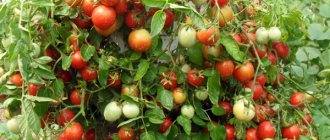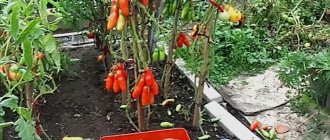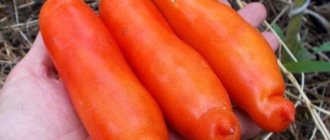Characteristics and description of the Budenovka variety with photos
The Budenovka variety was developed by the Moscow LLC GISOK-AGRO and is recommended for cultivation in closed ground (greenhouses and hotbeds) in all regions of the country.
The variety is relatively new - it was included in the State Register in 2002.
- The Budenovka tomato belongs to the group of indeterminates, the natural growth of which is not limited.
- The bush is sparsely leafed, the foliage is ordinary, dark green. The stem is thin and requires garter.
- The variety is highly valued for its excellent taste and marketable qualities of the fruit.
- The average weight of one of them is 200-300 g, but with some agricultural technology tricks you can achieve a weight of 800 g.
- In appearance, Budenovka resembles the famous variety Bull's Heart - the shape is the same heart-shaped, ribbed, and the color when fully ripe is pink, sometimes red. If you turn the tomato upside down, it will really resemble a budenovka.
- The skin is thin but dense. The pulp is fleshy, sugary, very aromatic.
- The taste is sweet and sour, pronounced, which is not typical of all tomatoes.
- The pulp contains lycopene, beta-carotene and a complex of vitamins. The total share of dry matter is 5%.
The purpose of the fruit, according to the manufacturer, is salad. Budenovka is usually consumed fresh and used for sauces and dressings.
But some gardeners note that the fruits of Budenovka can be preserved well and are suitable for pickles and do not crack.
Description of the bush
The tomato variety Budenovka belongs to the indeterminate type. The growth point of its lash does not end with a flower bud; the shoot can grow unlimitedly. During the growing season, it is necessary to pinch the top of the vine 45 days before the end of the season, so that flower clusters are not formed in vain, the fruits of which will not have time to ripen.
Budenovka tomato bushes are quite tall and can reach a length of 1.5-2 meters. The stems of the variety are thin and require garter, as they may not withstand the load of fruit.
The bushes are weakly leafy; 6-8 clusters are formed on one plant. The leaves are medium in size, typical in shape, dark green, wrinkled, devoid of pubescence.
The inflorescences are simple, the first is formed above the 10th leaf, the second and subsequent ones are formed after 3 leaves. Each inflorescence bears 6-12 fruits.
The roots of the plant are powerful and grow within a radius of 50 cm in all directions.
In terms of fruit ripening time, Budenovka pink tomatoes are classified as mid-early. The first ripe fruits can be removed from the bush after 105 days from the date of emergence of the crop. Ripening occurs quickly, almost all the fruits on the cluster ripen at the same time.
Budenovka tomatoes show relative resistance to common diseases. The manufacturer recommends cultivating them in open ground, greenhouses, and under film covers.
Attention! In an open-air garden, the vine will reach a smaller size than in a greenhouse. In the southern regions, this tomato variety gives a good harvest in garden beds in open ground.
Productivity
One of the main indicators of a variety that gardeners are especially interested in is productivity.
The Budenovka variety is one of the most productive, and a high rate is typical even when grown in not the most favorable conditions. For example, in regions with short summers, many tomatoes do not have enough light for increased fruiting.
In the case of Budenovka, such a problem does not arise - even in poor lighting conditions it produces a decent harvest.
Budenovka begins to bear fruit in the mid-early period - 100...110 days after the appearance of sprouts. In mid-July the fruits begin to ripen. The fruits on the bushes ripen over a long period of time, so it will not be possible to collect the entire harvest in one go.
Due to its high resistance to late blight, the fruits of this variety are not affected by it.
The yield of the harvest is extended, lasting 2...3 months.
From one bush per season they harvest from 3 to 5 kg of tomatoes, in particularly successful years - up to 7 kg. The total yield of the variety is up to 20 kg/m2.
Not in all regions of the country, summer residents can afford to pick tomatoes for another 3 months after the first fruits appear. In cold areas, where summers are short and cold sets in quickly, ripening technology is used.
If you pick Budenovka tomatoes at the stage of milky ripeness and put them in boxes for ripening in a dark, dry place, the variety will exhibit excellent keeping quality. Fully ripened fruits do not last long.
An amazing property of Budenovka fruits is that they ripen “from the inside.” This means that even with the skin seemingly not fully ripened, the tomato pulp is already ripe.
Disease resistance of the variety
The Budenovka tomato variety is rarely affected by major crop diseases. Seed producers and gardeners always note resistance to late blight, which is especially important due to the extended fruiting period, often lasting until October.
This does not mean that preventive treatments of tomatoes can be neglected, especially if other nightshade crops are grown nearby. Simply, with timely spraying with biological preparations, it is possible to avoid the use of chemical fungicides.
Pros and cons of Budenovka tomato
And although Budenovka appeared on the market relatively recently, it has already managed to win the hearts of Russian gardeners.
This variety will give odds to any hybrid:
- It is highly resistant to diseases.
- Gives reliable, stable harvests regardless of weather conditions.
- At the same time, the varietal taste qualities of Budenovka are much higher than those of most productive, but practically tasteless hybrids.
In addition, replacement material from the fruits of the Budenovka variety can be collected independently and without spending financial resources on its purchase annually.
Other positive qualities of Budenovka include:
- decent size fruits;
- taste characteristics of tomatoes;
- good yield;
- ease of care;
- stable yield under unfavorable growing conditions.
The list of disadvantages is much shorter than the list of advantages, and the points indicated in it are not significant. Each gardener will be able to provide:
- timely stepsoning;
- garter (organization of support).
In general, against the background of the above advantages, these disadvantages are quite insignificant.
Resistance to diseases and pests
The Budenovka tomato has average resistance to major tomato diseases. Carrying out preventive measures will make it impossible for late blight to spread throughout the site.
When choosing the time of treatment, you need to take a closer look at the weather. If it is hot and the humidity is not high, the late blight fungus will not be able to increase its virulence and will appear on the fruits. It's a completely different matter when it gets colder and the rainy season begins. Or moderate warmth during the day gives way to coolness at night. In such weather, the mushroom will quickly “grow down” on the tomatoes, and the harvest will be lost.
When choosing a drug for treatment, read the instructions. Particular attention should be paid to the waiting period from the moment of spraying to the moment of consumption of tomatoes. If the growing season is just at the beginning, then the waiting period can be long. If the tomatoes are already turning brown, then it is better to use a “light” chemical with a short waiting period.
Advice! Do not use one antifungal drug constantly - it is addictive. Alternate them.
If we consider the drug "Quadris", then it has a waiting period of 5 days. This means that fruits can be harvested 5 days after treatment. The most effective drugs for preventing late blight are:
- "Quadris";
- "Rapid Gld";
- "Consento";
- "Revus";
- "Strobe."
Among biological preparations, gardeners are recommended to use the Fitosporin treatment product.
Features of cultivation
Despite the fact that the Budenovka tomato is quite unpretentious, there are several nuances of growing it to obtain maximum yield.
Tomatoes are grown by seedlings, since the ripening period does not allow growing seedlings at home.
It is recommended to sow 60...65 days before the planned date of planting in the greenhouse.
The planting pattern is 60x30, 3-4 seedlings are planted per 1 m2 of area. The exact value depends on the shape of the bushes. If the bush grows into 1 trunk, then you can reduce the distance between neighboring seedlings and plant 4 pcs./m2. However, growing in 2…3 stems is considered the most optimal. Accordingly, in this situation, no more than 3 bushes per 1 m2 are planted.
All the efforts of the gardener in the period after planting the seedlings are aimed at the proper development of the bushes and increasing productivity. To begin with, the plants are supported or tied to a trellis under the ceiling of the greenhouse.
Thin trunks of bushes are not able to support heavy fruits on their own. During the period of active growth of bushes, pinching is carried out periodically.
When the bushes reach a height of 1.8... 2 m (and in low greenhouses 1.5 m), you need to top them - pinch the top and limit growth.
During the period of the appearance of ovaries, in order to obtain larger tomatoes, it is necessary to ration the number of ovaries - leave 6...8, remove the rest. If there is no desire to grow very large fruits, then there is no need to standardize the number of ovaries.
Otherwise, all operations for caring for Budenovka bushes are quite standard:
- moderate watering;
- ventilation of the protective structure;
- timely balanced feeding;
- loosening and hilling.
Despite the increased resistance of the variety to some crop diseases, it is recommended to treat plants as a preventive measure.
Features of planting and care
Proper planting and quality care are the key to success in growing the presented variety. If seeds are sown, harvesting is carried out in mid-March. Seedlings are planted in open ground a month later, that is, in mid-April.
First you need to prepare the soil. It is advisable to do this 1 year before planting tomatoes. The ideal option for planting Budenovka tomatoes would be beds where zucchini, cabbage, cucumbers, and herbs previously grew.
You should first soak the seeds in a weak solution of manganese. After a day, you can start sowing, placing seeds every 2 centimeters. Cover the bed with film until the seedlings sprout. When 3 leaves appear, you can transplant the tomatoes into separate cups with peat.
Advice! Before planting seedlings, it is necessary to fertilize each hole. Organic fertilizers can be used.
Ready-made seedlings are planted in holes, which are placed in a checkerboard pattern at a distance of ½ m from each other. To form beds, you must choose a well-lit place in the garden.
Features of care:
- Tomatoes need to be fertilized once every 1-1.5 weeks. Use any types of fertilizers. The first feeding is carried out 3 weeks after planting.
- It is worth loosening the soil according to need.
- Mulching is done immediately after planting the bushes. To do this, you need to cover the ground near the stem with hay or straw.
- Irrigation is carried out at first 2 times a week. Later, the number of waterings is reduced to 1 time per decade. Water should simply be poured at the root of the plant.
- When it reaches 0.5 m, the shrub requires pinching. You need to cut off the lower leaves and branches. The procedure is carried out once every 2 weeks.
- When small tomatoes begin to appear, it is worth installing supports to which the bushes will be tied.
Caring for Budenovka is easy, since you do not need to create special conditions for growing tomatoes. Therefore, many summer residents choose this particular variety for their plot.
Reviews from gardeners who planted
On the Internet you can find many reviews from gardeners who planted Budenovka on their plots. It is worth noting that the number of positive reviews far exceeds the number of negative ones.
Perhaps the problems with growing the Budenovka variety were associated with the purchase of low-quality seed material or with the neglect of the basic rules of tomato agricultural technology on the part of the gardener himself.
Klodi:
“I have only two favorite varieties - Budenovka and Black Prince. I grow Budenovka for canning - the tomatoes do not crack, they are fleshy and dense. The variety is very productive"
Capitolina:
“I tried a bunch of varieties on my site, and Budenovka also didn’t go unnoticed. I remember the variety as a good large tomato with high yield. My fruits did not weigh 800 g, but in principle the weight was decent - 300...400 g. They responded well to fertilizing with ammonia. I used the fruits for lecho and salads.”
Iris:
“If you pick slightly browned fruits, in a couple of days they will ripen on the windowsill, and the taste will be the same as when ripened on the bush. But plant productivity will increase by 1.5...2 times if tomatoes are not left to ripen on the branches until the stage of brown ripeness."
Amadeus:
„ I purchased seeds many years ago and have never had a bad result. Tomatoes are planted annually: Budenovka, Heavyweight of Siberia, and Improved Spanish Giant.”
Ekaterina Beltyukova:
“For me, Budenovka is a disappointment variety. Against the background of some advantages (does not crack, large, fleshy) there are two significant disadvantages: faded color (light pink, I like bright tomatoes that are pleasing to the eye) and an incomprehensible herbaceous-sour taste.”
Advantages and disadvantages of culture
With proper cultivation and care, the plant has no disadvantages. Among the advantages of the culture, one should highlight the unpretentiousness and high fertility of the plant. The plant is suitable for cultivation by both beginning summer residents and professional breeders. Budenovka gained a lot of positive reviews from those who grew this tomato.
What varieties are there similar to Budenovka? This variety is a first generation hybrid and has a number of analogues in terms of technical characteristics and taste. The main competitors of Budenovka are the tomato crops Aelita and Velmozha.
Both varieties have similar quality indicators, are resistant to diseases and have high yields, but Budenovka is easier to grow
Photo gallery
Prepared tomato seed Budenovka
Ripe fruit
Planting in open ground
Tomato seedlings Budenovka
Landing algorithm
Tomato Budenovka, description of the variety, photos from experienced gardeners show it as a crop with rather thin, delicate seedlings. Its removal to an open place or to a greenhouse is possible only after 1 flower cluster appears on the plants. The usual planting time is 50 days from the moment the sprouts appear. The air temperature should remain stably above +16 °C, and the soil should warm up to +10 °C and above.
Sequence of work:
- Before planting, sprinkle a handful of humus or 10 g of superphosphate into each hole.
- The planting areas are spilled generously with water.
- The seedlings are carefully removed from the glasses. To remove plants from containers with a lump of earth, watering is stopped several days before planting.
- Peat pots should be cut in several places for better root germination.
- The stems are buried a little more than when growing seedlings. It is permissible to dig up elongated plants to the first true leaves.
- After planting seedlings, abundant watering with heated water is required.
Mulching with cut grass, sawdust or straw speeds up the rooting of seedlings. This technique for the Budenovka variety is used both in open beds and in greenhouses or greenhouses. If there is a danger of return frosts, temporary shelters should be provided for plants in open beds.
The nuances of growing in open ground and in a greenhouse
Planting seeds and growing seedlings for the ground and for a greenhouse are no different. When choosing a place to grow tomatoes, take into account the climatic characteristics of the region and the condition of the soil for planting.
When planting in open ground, it is easier to maintain correct crop rotation; it is enough to plant tomatoes in an area where cucumbers, zucchini, carrots or dill previously grew.
In a greenhouse with crop rotation, things are more complicated. Gardeners give the following recommendations:
- Prepare the soil based on garden soil, peat, manure, sawdust (ratio 2:1:1:1), water with a solution of potassium permanganate for disinfection.
- Remove the top layer of soil (20 cm) from the greenhouse. fill in the prepared soil instead of the removed soil.
- Two months before planting tomatoes, sow early-ripening green manure crops, such as mustard and legumes, into the greenhouse. Before planting tomatoes, dig them up along with the soil.
The photo below shows tomatoes in a greenhouse and in open ground.










